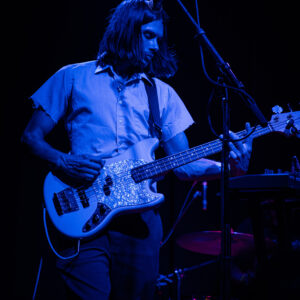I wrote this article for my college newspaper when I was interning at HOT 92.3 for the fantastic Production Director Ron Shapiro at 20 years-old. It was when I first started thinking about what radio needs to be, and it’s really interesting to read it seven years later to see, honestly, how it still hasn’t changed much at all.
Ron Shapiro got his start in radio in high school … in a meat locker. His school in Van Nuys, Calif. was a former hospital, and the space most suitable for a makeshift radio station was the same place that the hospital kept its frozen items, making for quite an uncomfortable broadcast environment.
And he loved it.
Working in radio had been his dream since he was seven years old, and the meat locker door opened to a career with Casey Kasem’s American Top 40, KIIS FM and now HOT 92.3. But, if he were starting a career today, would he do it all again?
Nope.
Commercial radio is a changing. With a declining number of listeners (especially among the younger, iPod crowd) and suffering advertisement sales, FM and AM radio is facing the fiercest competition since TV. While some efforts have been made to “save” the industry with gadgets like HD Radio, nothing has truly been successful, and longtime industry professionals like Shapiro are skeptical about its future.
“For radio to survive, it has to come up with something,” he said. “You don’t feel like you’re missing anything if you’re not listening [to it].”
Shapiro still loves radio, but he is wary of anyone trying to start a career in a field surrounded by such turmoil. When he was a kid, he would listen to the radio everyday from his home like others in the same generation. Now, he only listens to it sparingly in his car and hardly even has it on at work, which is in a radio station.
Commercial radio is suffering so much because of competition with other media, said Shapiro. Music on the Internet with sites like Pandora or YouTube, online radio stations, satellite radio and in-car iPods top the radio-killer list. According to Michael Keith in “The Radio Station,” overall listenership has declined 15 percent in the last 20 years, and time spent listening per individual has declined four percent since 2003.
“Why would I risk listening to something I don’t like on the radio when I could listen to something I actually do like on my iPod? And you can still simulate radio’s randomness with an iPod using shuffle,” said 22-year-old Chapman student Alex Barrett.
But this doesn’t mean radio is necessarily going to be replaced by other media, said Shapiro. It will just change. It needs to change to survive. It needs to be more personal, more “on-demand,” more versatile.
“Somehow, radio needs to be online-like,” he said. “Radio will survive by adapting to the times.”
However, according to Keith, radio continues to be the most pervasive medium in the world, even more so than the Internet, which is nonexistent in some Third World countries. Here, in the Los Angeles market, where there are countless other distracting mediums, 4 million people still listen to stations like KIIS FM every day.
“There is no patch of land … untouched by the electromagnetic signals from more than 40,000 radio stations worldwide,” Keith wrote. “Stations in this country reach 99 percent of all households.
Radio rose to popularity in the United States in the early 1920s. Millions of stationary receivers starting popping up in living rooms around the country, and families would gather around to listen in their homes. Shows like “Amos ‘n’ Andy” in 1929 caused people to stop what they were doing and tune-in, even causing local businesses to complain about suffering sales at those specific times, according to Keith. The next 20 years was truly the golden age of radio.
But television began taking radio’s audience in 1952. Many radio executives thought the popularity of TV would eclipse radio as the sole entertainment medium. But radio had it all wrong: it was trying to fight TV with the exact same type of shows. It wasn’t until radio embraced rock ‘n’ roll and began broadcasting top 40 music in 1956 that it found a role as an alternate to TV. Hearing artists like Bill Haley, Elvis Presley and Perry Como helped define radio as a medium for music.
But the problem now is: radio has been doing the exact same thing since 1956, said Shapiro. Top 40 music (now of more genres) still dominates the airwaves, and the deejay’s role exists mostly to introduce the next song. Keeping up this same pattern was acceptable for many decades, but with more and more young people turning to the Internet or their iPods for music today, radio needs to adapt, said Shapiro.
“Just like it changed 50 years ago, radio needs to change today,” he said
In his office, Shapiro glances at his desktop background. It shows the top 40 songs from 50 years ago. Peggy Lee, The Beatles and Paul Anka are on the charts. He changes it out every week. It reminds him of the heyday of his industry.
Although the digital revolution has allowed him to achieve much more as a programmer of a radio station, Shapiro said he has felt a significant decline in the enthusiasm of his people working in radio in the past couple decades.
“The morale within the building was so much different 20 years ago,” he said.
There are less company parties, the softball league of the past has been abolished and even passing people in the hallway feels a bit less spirited, he said.
But this doesn’t mean Shapiro isn’t still having fun at his job. It’s just that the attitude of those working in radio seems to reflect the status of the industry as a whole.
Steps have been made to change commercial radio, however, especially with the introduction of HD Radio a few years ago. HD Radio allows stations to utilize “new” FM waves, meaning they can broadcast a separate HD channel (for a subscription fee to listeners). Most stations use their second channel to broadcast a different format that would be attractive to its regular audience.
But HD Radio sales have been abysmal, and most consumers don’t even understand what it is. All HD Radio does is add more content, which isn’t what commercial radio needs, said Shapiro.
Satellite radio, which is considered a competitor to commercial radio, has been much more successful, but it only makes up two percent of radio’s listeners. So, in reality, not much has changed, and Shapiro thinks something bigger is on the horizon.
“Radio may just go to the Internet. Cars are still great, but the Internet is coming to the car,” he said.
But Sales Manager of Clear Channel Radio David Howard thinks radio will be able to standup to new media with its own advantages.
“The Internet is [too] targeted. If you want to reach the masses, there are very few forms [like radio] you can do that with,” said Howard.
Although Howard’s computer screen shows an Excel spreadsheet with advertising sales about 30 percent down from last year, he says it’s not radio that’s suffering; it’s the economy. Too many people are worried that radio is dying when it’s just feeling the same economic effects of any other business today, he said.
“Radio has survived every other threat that was going to take it out of business,” said Howard. “The future really is healthier than ever.”
While it seems agreed upon that radio will survive, Shapiro is worried that his job may not. He no longer has a formal contract with Clear Channel, he hasn’t had a raise in three years and a bonus isn’t even a consideration.
“I don’t think anybody in radio today can feel secure that they’re going to have a job next year,” he said.
But regardless of his future, Shapiro is satisfied with the eventful career he’s had in the business. In the 1980s, he worked on one of the most important radio shows in history: Casey Kasem’s American Top 40. He was there during perhaps the most infamous broadcast of the show, too. Kasem was reading his long-distance dedication segment, which, on that particular day, was about a family’s deceased dog Snuckles. However, the dedication came immediately after a song by The Pointer Sisters, and Kasem was upset that a sad story came after an up-tempo song.
Immediately after the dedication, Kasem screamed, cussed and ranted to Shapiro and everyone in the room about the mistake, which was recorded and leaked online many years later. And, according to Shapiro, there are even some vulgarities that the YouTube video omits.
For Shapiro and other longtime professionals, it’s obvious that radio back then simply had more life. But it’s out of the meat locker and into the computer – radio is headed in a new direction.
It just seems that no one really knows exactly which way that is.






